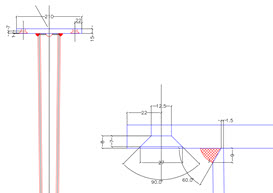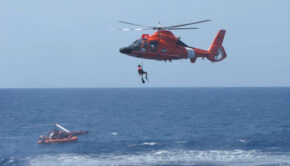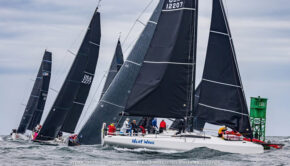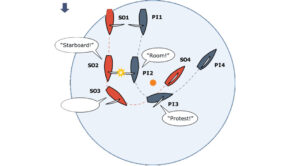Safety standards are an illusion
Published on January 12th, 2022
Jean Sans, who helped to develop the Channel Handicap Rule, the precursor to the IRC Rule, and now an expert consultant in the marine industry, finds new safety standards by World Sailing to be an illusion. Here is his view:
The application of the prescriptions of the 2020-21 World Sailing Offshore Special Regulations (OSR) stated in 2020 in Section 3.02 had been postponed to January 1. 2022. This is now effective – see the publication of the 2022-23 World Sailing OSRs.
Consequently, for all races in Categories 0 to 3, the elements within 3.02 (Watertight and Structural Integrity of a Boat) are applicable.
3.02 – Watertight and Structural Integrity of a Boat
3.02.1 Essentially watertight and all openings shall be capable of being immediately secured. Centreboard, daggerboard trunks and the like shall not open into the interior of a hull except via a watertight maintenance hatch with the opening entirely above the Waterline
3.02.2 Effective 1 January 2022: Structural Inspection – Consult the owner’s manual for any instructions for keel bolt checking and re-tightening. The following inspection to be conducted by a qualified person externally with the boat out of the water. Check that there are no visible stress cracks particularly around the keel, hull/keel attachment, hull appendages and other stress points, inside the hull, backing plates, bolting arrangements and keel floors. (See Appendix L – Model Keel and Rudder Inspection Procedure)
3.02.3 Effective 1 January 2022: Evidence of a structural inspection in accordance with 3.02.2 within 24 months before the start of the race or after a grounding whichever is the later
3.02.4 Effective 1 January 2022: Inspection after Grounding – an appropriately qualified person shall conduct an internal and external inspection after each unintentional grounding
I haven’t changed my opinion since 2020 when I found these requirements didn’t make sense to me, and now am surprised that this initiative was not simply canceled. I am especially perplexed about the implementation of these conditions, and especially about their validity and the reliability of the results.
If we refer to the many expert reports (public documents for the most part) and to those that I have had to manage in France, as a legal expert for a Court, it appears that the main cause of the loss of a keel is an error in the design of the keel and/or its attachment to the hull and/or its manufacture.
A contact with a rock or another obstacle can generate structural damage (this is not always the case), but this event is always identifiable because the crew felt the consequences of the collision. This is not the case when the keel becomes detached from the hull due to an internal mechanical failure generated by stresses during navigation.
The investigation following a collision with an external object almost always results in an insurance claim. Generally, the damage leads the expert commissioned by the insurers to have the ballast removed. In this case, the inspection is complete and the appropriate measures are taken.
In the case of a search for a potential internal ruin during development, therefore insidious, it is much more complicated, because the inspection by the expert (the marine surveyor) will be only visual and without (or it is very rare) having the structural and assembly plan and design of the keel.
What to do for a modern boat whose bottoms are completely counter-molded or when we are in the presence of a boat or a metal frame, practically inaccessible takes over the fixing of the keel, or the samples are unknown, or the manufacturing plan of the keel is non-existent or not available.
I might add that visually you can’t be sure about the material of the keel or the rudder stock.
A lead keel should contain 2-4% antimony (to improve its mechanical performance), but from experience I can say that the keels of some recent boats did not contain any.
The same applies to cast iron… is the keel made of grey cast iron, malleable cast iron, GS cast iron? The mechanical characteristics between these different types of cast iron are almost of the order of 1 to 8.
I can make identical remarks for “stainless” steels, as between a 316L and a 17-4Ph, between the different aluminum alloys, the sheets used for the construction of the keel sails in mechanically welded (between a standard steel sheet and a Veldox sheet, which is always steel, we go from 300 Mpa to 1250 Mpa of resistance to rupture)
 For keels made of welded steel, 90% of the damage is due to the design and layout of the weld seams and to the heat treatments (mandatory) following the welding process.
For keels made of welded steel, 90% of the damage is due to the design and layout of the weld seams and to the heat treatments (mandatory) following the welding process.
The type of welding assembly shown to the right should NEVER exist… and yet it still exists on some boats.
For “lead” keels, the design of the internal steel structure, which is over-molded and therefore completely invisible, is often very complex and entirely different from one builder to another.
Another cause of keel losses is the failure of keel bolts or rudder stocks due to fatigue stresses. Material fatigue is a very complex and mechanically quite “hard” area, but investigations and analyses are often destructive.
The exception is for rudder stocks, where after removing the rudder and cleaning the lower bearing area, a penetrant test is performed (50 € of products). This test allows us to identify the existence of any cracks invisible to the naked eye. If cracks are present, the rudder must be discarded because this means that fatigue cracking is developing.
For keel bolts, the dye penetration test is of no interest; only the location of the bolts or ballast fixing screws is important.
There was a time when builders replaced the two lines of ballast fixing bolts with a single line located in the plane of symmetry of the boat. The diameters of these “axial” studs were 1.5 times larger, but their position in the plane of symmetry of the boat made them sensitive to alternating bending stresses at each tack or heel, i.e. millions of cycles.
This is the ideal range of fatigue by alternating bending and eventually the rupture by cracking of the pins, thus the loss of the keel. Boats equipped with this type of mounting still exist!
The owner’s manual (EC Directive) does not foresee any intervention on the tightening of bolts, studs or keel assembly bolts. It is important to understand that the owner’s manual is a document for the use of the boat written for a non-technician (the owner), but in no case is it a workshop manual allowing to perform this type of operation.
The weights are tightened with a torque wrench (a professional tool) and in addition, in 90% of the cases, the screw/nut heads are covered with a laminate, when they are not under the motorization.
In any case, as the boatyards use polymerizing gasket (Sykaflex type), re-tightening is a nonsense, because if there is a water leakage through the keel/hull connection, it is because the gasket is detached from one of the supports (metal or laminate). Re-tightening will not reattach the Sikaflex joint.
A Sykaflex seal does not “work” like an O-ring. A Sykaflex joint is only active if it is glued to both parts.
It should be added that a very common practice in the early 2000s in the shipyards was to use casting resin at the time of ballast installation… firstly, tightening is literally impossible, everything is solidified, secondly, de-skimming without destroying the bottom of the boat is practically impossible.
Finally, I would like to mention the existing damage to the 17-4Ph steel rudder stocks, which are immersed in the lower bearing. This type of assembly is fairly widespread (lower spherical bearing immersed).
If the boat is moored for a long period in a very calm harbor area, where there is little water movement, the sea water surrounding the bearing housing and the rudder stock is not renewed. The combination of this type of steel with high mechanical qualities and this stagnant sea water generates micro cracks on the surface which cause cracks to form and eventually lead to fatigue failure of the roving.
All this shows that the field of mechanical links and steering devices is very complex. The latest standard dealing with sampling (ISO 12215-9) required years of work by the various committees and forced the Notified Bodies (in France, the ICNN), as well as the design offices of architects and builders, to equip themselves with ad hoc calculation means.
Being very pragmatic, I think that visual inspections will be unreliable and therefore will not contribute to the safety of the boats.
I would like to finish by specifying that the CE Certification of pleasure boats concerns exclusively the “MARKETING ON THE EUROPEAN MARKET” and in no case a follow-up after this marketing and in particular in case of repair following a disaster or the ageing of the boat
Conclusion
World Sailing, through its Special Regulations Committee, which writes the OSR, acts as a control body and thus issues, with these “3.02” prescriptions, an individual sailing permit for each boat. And this without having a technical structure supervising these interventions, since the responsibility will rest on the decision of the organizers to accept or refuse the document signed by the “competent person”.
In France, the sailors (military) say: “Paint on rust equals cleanliness.”








 We’ll keep your information safe.
We’ll keep your information safe.